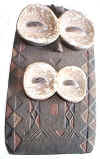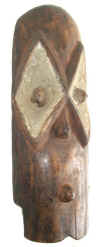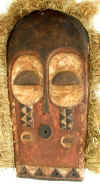 |
 |
 |
TRIBAL AFRICAN ART
BEMBA (AWEMBA, AYEMBA, BABEMBA, BEMBE, WABEMBA,
WEMBA)
Zambia, Democratic Republic of the Congo
The name Babemba means “the people
of the lake.” The 60,000 Bemba settled mostly in northeast of Zambia, but also in the
southeast of the Democratic Republic of the Congo. They share a number of traits with
their neighbors on the shores of Lake Tanganyika: the Lega, the Buyu, and the Binji. The
territory surrounding them is covered with forests, plateaus, and wooden savannas
traversed by rivers. The Bemba have the reputation of being a proud, hard people who
learned the art of the hunt and the harvesting of honey. They practice slash-and-burn
agriculture; a social, ritual, and economic value is connected to the hunt. Villages,
consisting of about thirty huts were abandoned every three to four years once the soil
became exhausted. The Bemba borrowed the bwami association from the Lega, but they
have also other secret societies. Once circumcision had been performed, the bwami
essentially consisted of dances, songs, and the handling of objects. Initiates would use
figures sculpted from elephant tusks or wood, wooden masks, and, as emblems of the highest
levels, a stool or an anthropomorphic figurine. The initiation in the elanda male
society ended with the appearance of the Mask, the viewing of which was forbidden
to the non-initiated. Otherwise, this oval mask that sometimes sports antelope horns was
entrusted to a dignitary and hidden outside the village in a secret place. The ibulu
iya alunga (“the protector of honey”) mask, used in the male alunga (kalunga)
society, is unique in form. It is worn on the head like a helmet and sometimes ends at the
top in a huge crest of feathers and porcupine quills. It represents a powerful bush
spirit. Kept in a sacred cave, the mask is taken into the bush during the secret
initiation of new members. The alunga association was in charge of the cult of the
hunt, as well as social order and public dances. The wearer of the mask, hidden completely
under a fiber costume, would be a member of high rank who knew the dances and the manner
of speaking and singing in a guttural voice.
The Bemba people never produce large
statues, but small statuettes are made in the western part of their territory. The
sorcerers and healers used the statuettes for their rites of magic and healing. It is
thought that certain female statuettes may have been used as fecundity figures – they
stand on short legs with their hands resting on their abdomen.